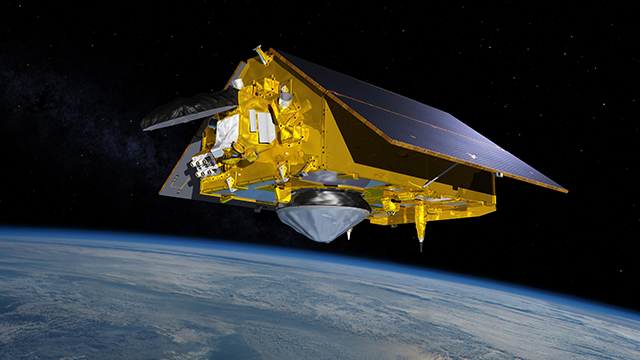
Sentinel-6/Michael Freilich
Jump to: Mission Objectives, Mission Instrumentation, Mission Parameters, Additional Information
Mission Images:

Source: NASA-JPL/CalTech
Mission Objectives:
The Jason-CS mission is a joint oceanography mission to monitor global ocean circulation, climate change and sea-level rise. The Sentinel-6A Michael Freilich/Jason-CSA satellite is the follow-on to the TOPEX/POSEIDON, Jason-1, Jason-2 and Jason-3 satellites.
The Jason-CS Programme – established under Declaration EUM/C/83/15/Dcl.I – constitutes EUMETSAT's direct contribution to the funding, development and implementation of the Sentinel-6/Jason-CS mission, also involving ESA, EU, NOAA, NASA, and CNES.
Sentinel-6/Jason-CS aims to continue high precision ocean altimetry measurements in the 2020–2030 time-frame using two successive, identical satellites, Sentinel-6/Jason-CS-A and Sentinel-6/Jason-CS-B. A secondary objective of Sentinel-6 is to collect high resolution vertical profiles of temperature, using the GNSS Radio-Occultation sounding technique, to assess temperature changes in the troposphere and stratosphere and to support Numerical Weather Prediction.
The two Sentinel-6/Jason-CS satellites are planned to have 5.5 years lifetime each (plus 2 years consumables). The Sentinel-6A/Jason-CS-A satellite will be launched in the end of 2020 to guarantee adequate overlap with Jason-3, whereas the Sentinel-6B/Jason-CS-B will be launched in 2025 and will provide full continuity of service until 2030 and beyond.
Precision orbit determination is a fundamental requirement for achieving the goals of the Jason-CS mission. The SLR data play an important role in two ways (1) providing· strong tracking information to complement GNSS and DORIS, and (2) providing a unique and unambiguous verification of the absolute radial orbit accuracy.
Mission Parameters:
| Satellite name: | Sentinel-6A/Michael Freilich |
| Sponsor: | NASA/ESA/EUMETSAT/NOAA/CNES |
| Expected Life: | 5.5 years |
| Primary Applications: | Ocean altimetry, vertical temperature profiles |
| COSPAR ID: | 2008601 |
| SIC Code: | 4380 |
| NORAD SSC Code: | 46984 |
| Launch Date: | 10 November 2020 |
| RRA Size: | |
| RRA Shape: | spherical surface |
| Reflectors: | 9 cubes |
| Size of Reflector: | ∼ 32mm diameter |
| Orbit: | slightly elliptical |
| Orbital period: | 6745.7605 seconds |
| Inclination: | 66.042 degrees |
| Altitude: | Min 1339.4 km / Max 1355.9 km |
| Eccentricity: | 0.000098 degrees |
Related Information:
- EUMETSAT's Sentinel-6/Jason-CS webpage
- NASA/JPL's Sentinel-6/Jason-CS webpage
- ESA's Sentinel-6/Jason-CS webpage
- CNES's Sentinel-6/Jason-CS webpage
Other information:
Publications:
- Donlon C., Cullen R and Guiulicchi L. et al. (2021). "The Copernicus Sentinel-6 mission: Enhanced continuity of satellite sea level measurements from space", Remote sensing of the Environment, 258(112395), doi: 10.1016/j.rse.2021.112395
- "General Report of the 2022 Ocean Surface Topography Science Team (OSTST) Meeting", Venice, Italy, October 31 – November 4, 2022, edited by P. Bonnefond, J. Willis, S. Fournier, E. Leuliette, R. Scharroo, C. Donlon. URL: https://www.aviso.altimetry.fr/fileadmin/documents/OSTST/2022/OSTST_2022_Meeting_Report.pdf.




